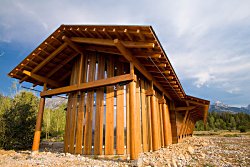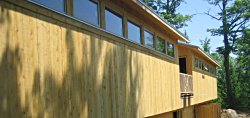Architecture.2007, Savannah, GA
October 3-6, 2007
Clivus Presentation: Friday, October 5, 2007, 2:00pm – 3:30pm
Greenbuild, Chicago, IL
November 7-9, 2007
|
| eFact |
Running the Well Dry
The Ogallala Aquifer, which supplies drinking water and irrigation to much of the Great Plains and Southwest United States, is being pumped out 32x faster than it can recharge. If it continues to be pumped out at the current rate, the aquifer will run dry in the lifetimes of our grandchildren.
source: The Sierra Club |
| Also of Interest |
Top 10
This summer, Clivus Multrum won a Top 10 Green Building Product 2007 award from Sustainable Industries. We also made our second TV appearance in a year, this time on the Discovery Science Channel show, Eco Tech.
Maintenance Services
Did you know that Clivus can arrange to provide your facility with composting system maintenance services? Clivus offers a variety of maintenance options to meet your needs. No matter where your facility is located, we’ll come to you or work with local subcontractors to ensure that the job is done right. Call us at 800-425-4887 for more information. |
|
Greetings from Clivus Multrum!
In this issue, we present two recent green building projects using Clivus technologies—one at Grand Teton National Park, Wyoming, and the other at a YMCA camp in Quebec. While the countries are different, the motives in both cases are the same—satisfy the need for toilets and protect each location’s natural environment.
A Gift of Nature
 |
| LSR Preserve's new visitor center |
The Laurance S. Rockefeller Preserve is an 1106 acre lakeshore property bordering the southwest corner of Wyoming’s Grand Teton National Park. The Preserve, which has been the property of the Rockefeller family since 1932, is scheduled to be donated to the National Park this fall. The Park spans an area of nearly 310,000 acres, and its craggy mountains, clear lakes, and abundant wildlife make Grand Teton a favorite destination for over 2 million hikers, fishermen, bikers, cross-country skiers, and others from around the world, every year.
When Laurance Rockefeller decided to donate the Preserve to Grand Teton in 2001, he envisioned that it would become, “a place of physical and spiritual renewal… a model for achieving balance between preservation of natural values and public use…” In order to facilitate public use and enjoyment of the Preserve, Rockefeller directed that all pre-existing structures and roads be removed from the property. These roads and structures have now been replaced with restored natural landscapes, a new visitor center, three restroom facilities, and eight miles of new trails to serve the expected 41,000 yearly visitors to the Preserve. In order to carry out Rockefeller’s vision, Carney Architects and M-E Engineers designed the facilities using environmentally responsible techniques and technologies, which both protect the surrounding natural areas and make them more accessible and enjoyable for visitors.
| The Preserve is an amazing and pristine piece of land that is a great gift to the public. |
The new visitor center, which serves as the main entry-point into the Preserve, is a one-story, 7500 square foot facility built to achieve the U.S. Green Building Council’s highest level of certification—LEED Platinum. The Park Service has embraced the challenge of maintaining the Preserve in a way that benefits both visitors and the natural environment. The visitor center uses one small Clivus Multrum Composter with a foam-flush toilet fixture to serve staff. The foam-flush fixture requires only 3-6 ounces of water and a drop of soap to flush waste down a conventional 4-inch drain line. This cuts water used for flushing by over 97%, as compared to conventional 1.6gpf toilets.
The three additional restroom buildings, all of which are either partially or completely solar-powered, use a total of ten larger Clivus systems with dry toilet fixtures to serve visitors. These systems eliminate the need to use water for flushing, and prevent toilet waste from polluting surface and groundwater, instead converting the nutrients in human waste to valuable fertilizers that will be used locally. The composting systems in all four buildings will be maintained by Clivus.
Other sustainable materials and technologies used in the new construction include recycled denim fabric insulation, energy efficient lighting and daylighting techniques, and native vegetation. Meghan Hanson of Carney Architects says, “It was important to the team that the building and grounds be designed to reflect and celebrate [Laurance Rockefeller’s] love and conservation of the environment. The Preserve is an amazing and pristine piece of land that is a great gift to the public. The buildings on this land needed to be a part of that.” And by undertaking the project with those thoughts in mind, the design team has helped the Park Service to preserve Rockefeller’s vision of a public place where visitors can enjoy and learn about nature without degrading it.
Camp with a Cause
 |
| One of YMCA Camp Kanawana's new restroom buildings |
Established in 1910, Camp YMCA Kanawana is an hour’s drive from Montreal. Spread over 550 acres and three lakes in the Laurentian Mountains of Quebec, Camp YMCA Kanawana welcomes nearly 1,000 campers each year. Programs run through the summer months, and campers ranging from 7-17 in age participate in a range of activities, including swimming, canoeing, kayaking, archery, rock climbing, and hiking. But while the activities sound pretty typical of a summer camp, YMCA Kanawana’s recent focus on environmental protection and conservation is an innovation.
In 2005, Kanawana began a $4.4 million, three year, eco-friendly development project. The project, which is being financed by a fundraising campaign as well as investments from the YMCA of Greater Montreal, includes modernization of existing buildings and construction of new ones, with a focus on protecting local ecosystems, conserving natural resources, and developing new programs to educate campers on sustainable living practices. When the development is complete, YMCA Kanawana plans to operate year round, hosting over 5000 children, youth, and adults yearly, and providing environmental education opportunities for all who come to the site.
The development is being undertaken in a number of phases. The first phase, completed this past June for the start of summer camp, included the replacement of all potable water systems (treatment and distribution), waste water systems (collection and treatment), as well as the construction of two new bathroom facilities, which house all toilets, sinks and showers for the camp. These new buildings replaced a number of smaller buildings scattered throughout the camp. In designing these new facilities, water conservation and pollution prevention were clear priorities, as old model ‘high-flow’ flush toilets were replaced with Clivus Multrum Composting Toilet Systems.
| According to Tierney, the combination of water saving measures at Kanawana... reduced water consumption this summer by 40-50% vs. 2006. |
While planning for the new facilities with the team of professionals, Daniel Tierney, Director of Development and Marketing for the YMCA of Greater Montreal, realized that the old flush systems were not only wasting clean water, they were producing lots of dirty water in need of treatment. Furthermore, due to the hilly topography of the site, much electricity was being used to pump water up to flush toilets in the existing bathroom facilities. After looking at a number of options, including low-flow toilets and other composting systems, the YMCA decided on Clivus systems based on their environmentally-friendly attributes, educational value and National Sanitation Foundation certification. Purchased in May of 2007, the 16 composting systems (32 toilets) are split evenly between the two, new buildings. According to Tierney, the combination of water saving measures at Kanawana, which include composting toilets, low flow sinks, and low flow showers, reduced water consumption this past summer by 40-50% vs. 2006. And after one full summer of operation (over 90,000 estimated uses), feedback from campers and counselors has been positive.
The next phase of Kanawana’s development involves the construction of new three season lodging for summer camp and school groups in the spring and fall, as well as two multi-use classrooms. The development project will culminate with the construction of an environmentally-friendly, four-season eco-centre facility, which will also serve as a family camp during the summer months. This new facility will include such ecological features as a green roof, solar powered heating, and an ecological waste treatment system. Changes to programs and camp operations, as well as signage located throughout the camp, will continue to help teach all who visit the camp the importance of respecting the environment. And because Kanawana is only building on previously developed land (less than 6% of Kanawana’s 455 acres) and doing it in an environmentally sustainable way, there will be plenty of natural environment for campers to enjoy in the future. |
